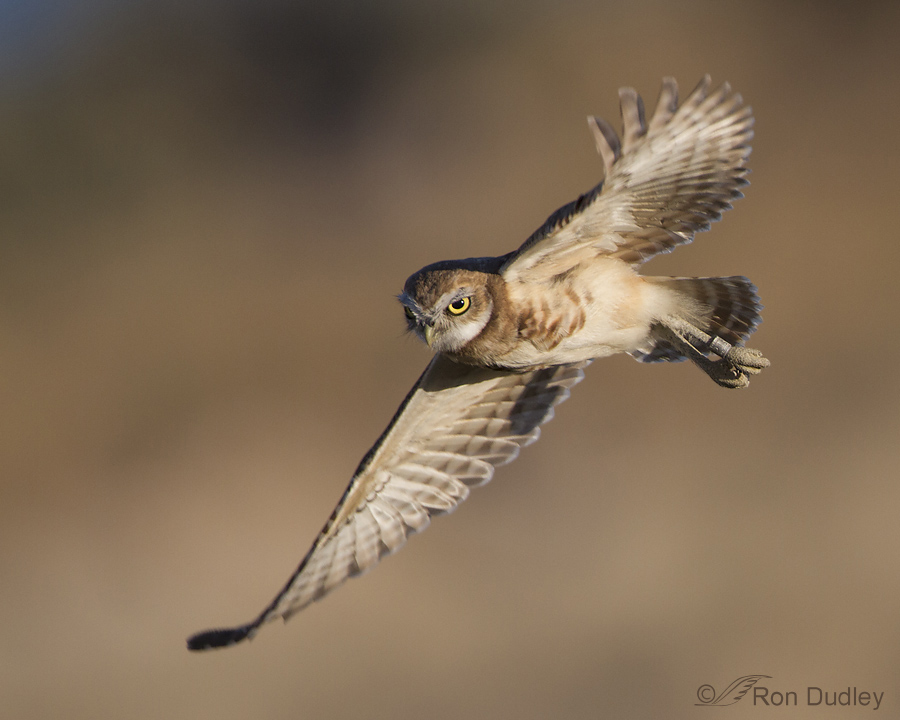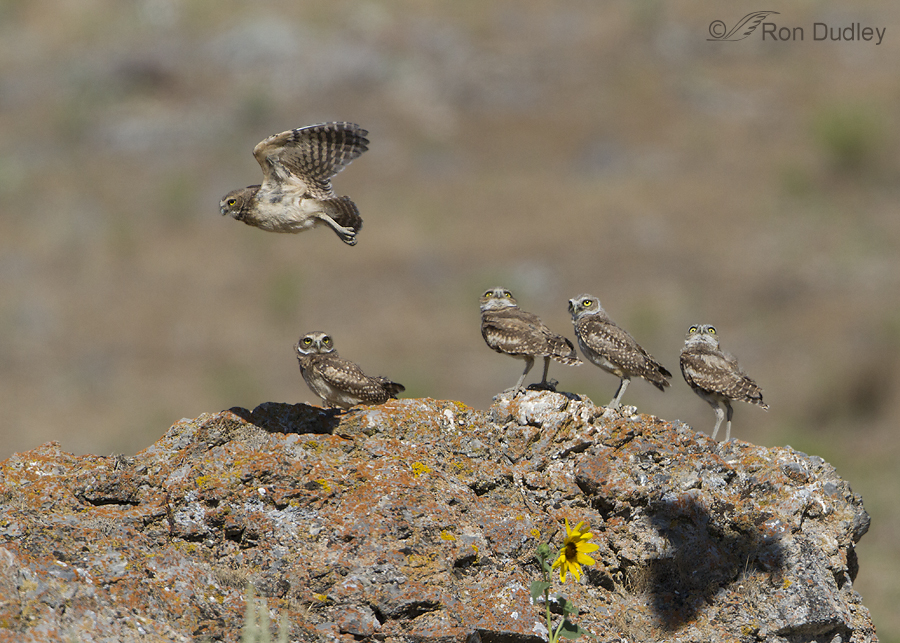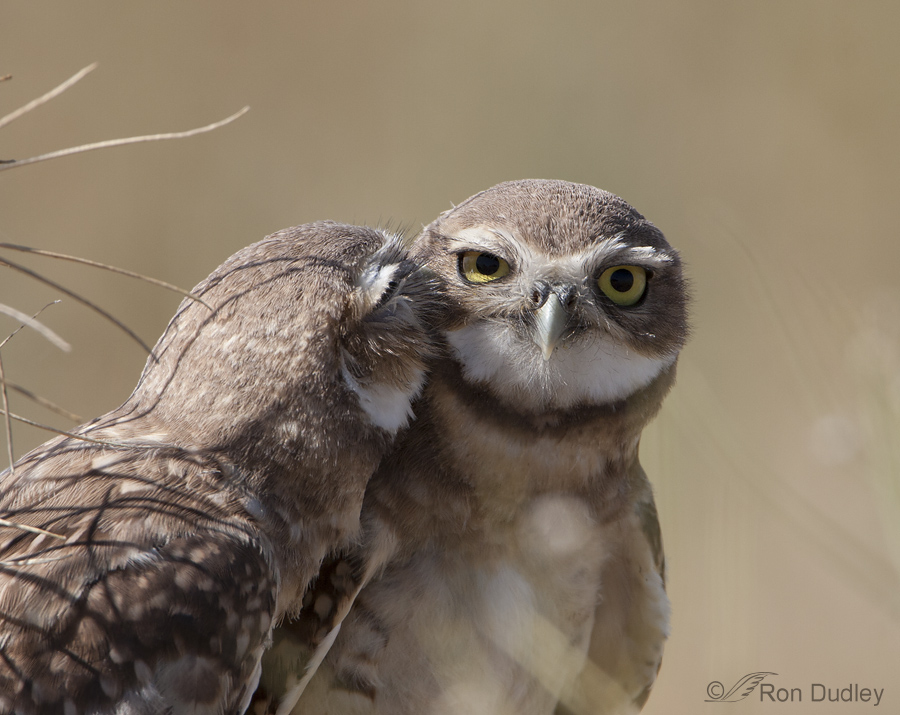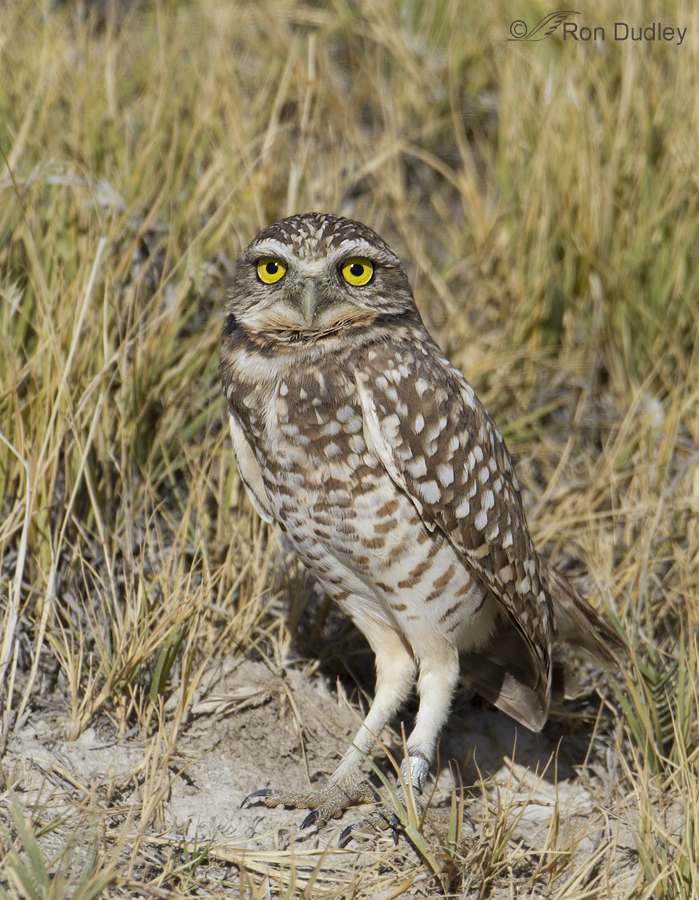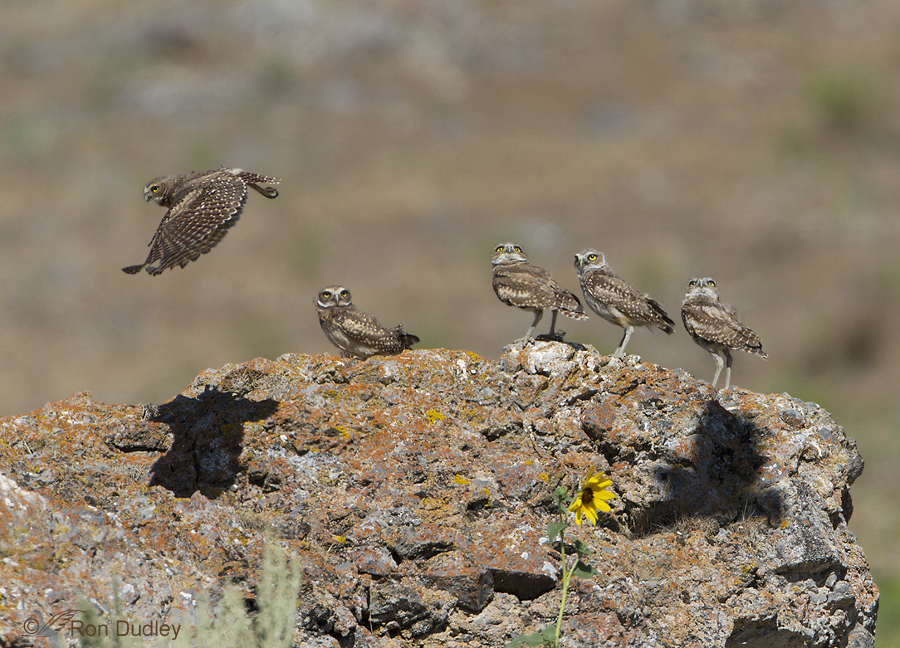Category: Burrowing Owls
Juvenile Burrowing Owls Practicing Take-offs And Landings
Friends
Finally! – Another Antelope Island Burrowing Owl
Burrowing Owl In Dramatic Side Light
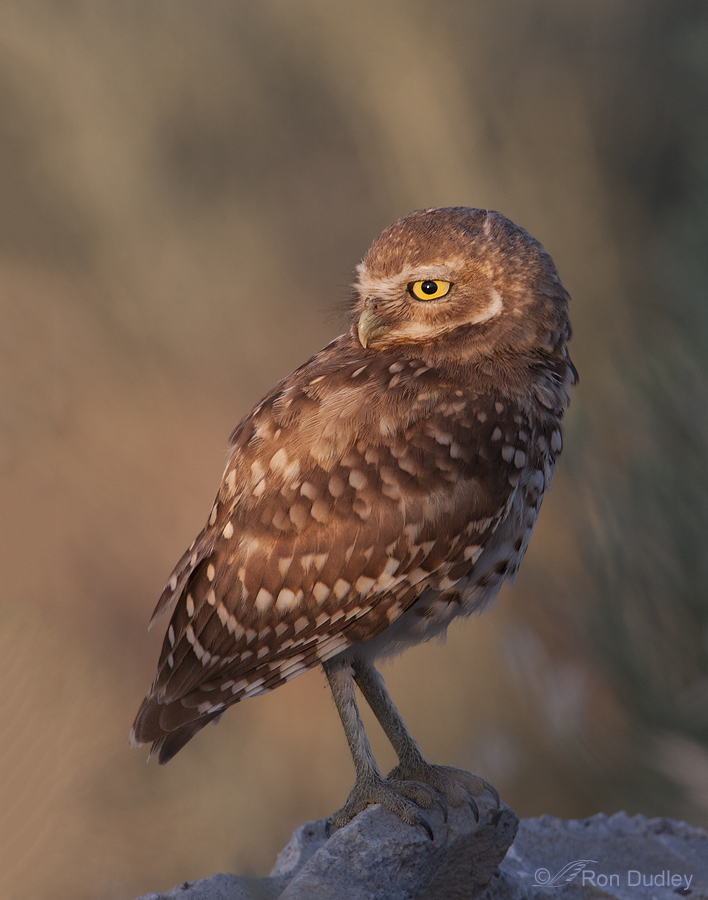
As every photographer knows, light angle can make or break an image. In static portrait shots especially, partial side lighting (at perhaps 45 degrees to your subject) emphasizes texture, patterns and shapes and helps to separate subject from background. It’s been said that side light “sculpts” your subject.
Three Burrowing Owls and More Challenges With Depth Of Field
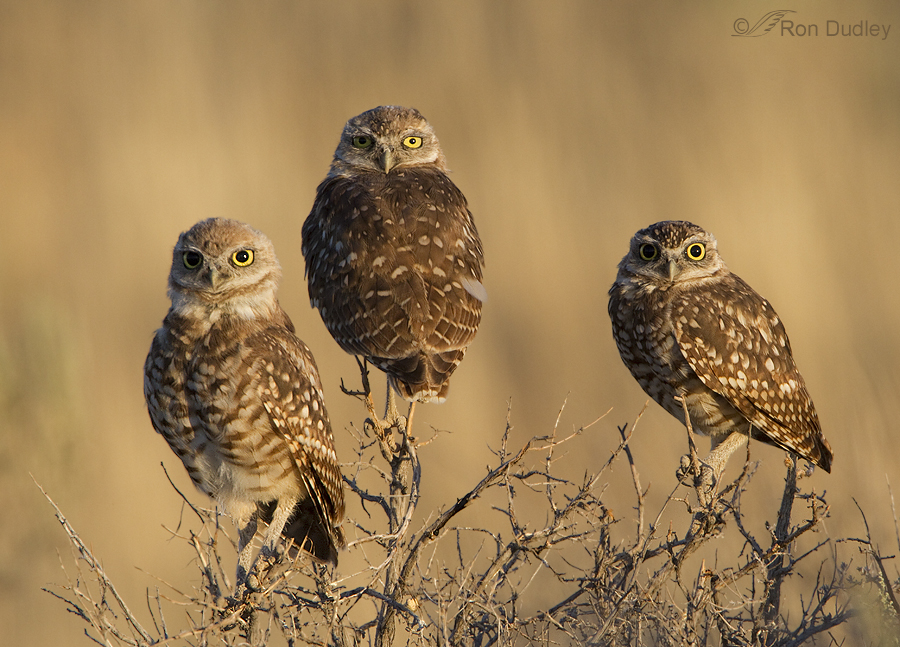
I’d been photographing a family of these birds for several weeks but typical of the species they were usually on the ground with obstructing vegetation in front of them or buried too deeply in the sagebrush. But as I approached them on this early August morning (in my pickup, from the road) there were two juveniles and one adult perched high on the sagebrush in nice warm light and there was a clean, pleasing background. My little heart went pit-a-pat at the opportunity but then I had to deal with the harsh reality of depth of field.
Juvenile Burrowing Owls Watching For “Incoming”
Burrowing Owl Youngsters – Hams Of The Bird World
Prepare to lose your heart if you ever have the opportunity to photograph or watch juvenile Burrowing Owls up close. They’re full of spontaneous antics and personality and they’re cute as a button.
Juvenile Burrowing Owl Posing Up A Storm
The antics of Burrowing Owls are always entertaining but “personality” simply oozes out of the juveniles. 1/400, f/8, ISO 500, 500 f/4, 1.4 tc, natural light, not baited, set up or called in This youngster had recently fledged and had begun to do a little exploring. On this early morning I found it on this perch just after sunrise. Thus was further away from the burrow than I’d seen any of the juveniles up to that point. 1/400, f/8, ISO 500, 500 f/4, 1.4 tc, natural light, not baited, set up or called in Within just a few minutes it gave me a variety of interesting poses – first an enthusiastic yawn… 1/500, f/8, ISO 500, 500 f/4, 1.4 tc, natural light, not baited, set up or called in and then long and drawn out wing stretch with left foot extended… 1/500, f/8, ISO 500, 500 f/4, 1.4 tc, natural light, not baited, set up or called in which concluded with the wing down and partially hidden behind the rock. Soon after this shot was taken the bird flew back to the comfort and security of the burrow and the rest of its family. Ron
Juvenile Burrowing Owl Parallaxing
Parallax is the effect where the position or direction of an object appears to differ when viewed from different positions. When an observer moves, the apparent relative motion of several stationary objects against a background gives hints about their relative distance which the brain can interpret to provide absolute depth information. As you can imagine this can be very helpful to birds for flight and for judging prey position. The movement required comes automatically during flight but it can also be provided while perched by exaggerated movements of the head in all three dimensions. Tipping the head also provides cues by changing the relative position of the eyes to the object being viewed. Learning to interpret this information takes practice so many juvenile birds do just that, owls in particular. Techs for the following images – most were taken at 1/640 or 1/800, f/9, ISO 400, 500 f/4, 1.4 tc, natural light, not baited, set up or called in. All images presented in the order they were taken. Several years ago I spent a lot of time over several weeks photographing a family of Burrowing Owls along the causeway to Antelope Island. Their burrow was very close to the road and they became almost completely acclimated to traffic so I was able to observe and photograph many interesting behaviors of both juveniles and adults from my pickup. Here, this juvenile is simply ignoring me (for the sake of convenience I’ll refer to this bird as a male though I have no idea what sex it…
Burrowing Owl – Same Bird, Same Perch, Different Angle
I’d like to make a point with this post. It’s one that every experienced bird photographer knows on some level but in the heat of the moment (it can be very exciting getting close to a “good” bird in nice light) it’s one that is easily forgotten. I’m getting much better at remembering but I still slip up occasionally. The point? Very minor changes in your shooting position can make huge differences (positive, negative or indifferent) in your photo. I’ll illustrate that point with a couple of shots that I took this morning. They’re not my best Burrowing Owl images but they’ll serve their purpose here. 1/160, f/7.1, ISO 640, 500 f/4, 1.4 tc, natural light, not baited, set up or called in This morning we think we found a new (to us) Burrowing Owl burrow right next to the road on Antelope Island that we’ve probably driven by several hundred times and never noticed. We don’t know for sure that it’s an owl burrow because we didn’t get out of the pickup and go tromping all over the area to inspect it. And right next to it was this juvenile owl, perched on a sagebrush, where we’d never seen an owl before. It had been cloudy but some light had begun peeking through a “crack” in the clouds when this shot was taken. It’s a “busy” perch and when the sun began to come out the bird was sidelit so I decided to change my position slightly… 1/320, f/7.1, ISO 640, 500 f/4, 1.4 tc, natural light, not baited, set up or…
The Banded Burrowing Owls Of Antelope Island
Populations of Burrowing Owls in North America are in sharp decline. They are an Endangered Species in Canada where only about 800 pairs remain as there has been a 73% drop in their numbers in that country over the last 30 years. They are a species of “special protection” in Mexico and they are “listed” in 9 of the 18 western states in the U.S. that they still occupy. The reason for this disastrous decline is not well understood, but “human activity” is strongly suspected. In order to get a better handle on what is happening to them, multiple banding studies are in progress and that includes Antelope Island. 1/2000, f/6.3, ISO 500, 500 f/4, 1.4 tc, natural light, shot from pickup window, not baited, set up or called in I first noticed banded juvenile Burrowing Owls on the island this past summer. Out of about a dozen juveniles in one area, several of them were banded but it was difficult to get a precise number because they’re hard to tell apart when some are in their burrows and the rest are flying all over the area. Most of the photos I have of banded owls were taken in early morning light but this one was taken later in the day (as you can tell by the position of the catch light and the angle of the shadows on the eyes), so the light was brighter and harsher. 1/1600, f/6.3, ISO 500, 500 f/4, 1.4 tc, natural light, shot from pickup window, not baited, set up…
Some More Burrowing Owls
I simply can’t resist photographing Burrowing Owls. 1/100, f/5.6, ISO 500, 500 f/4, 1.4 tc These youngsters often have a balance problem when they try to perch on the relatively unstable sunflowers, which can be a good opportunity for the photographer to get some interesting poses. One of the problems here was that the sun was just coming up and the light was very low as you can see from my very slow shutter speed. Even though this bird fluttered on the perch for quite a while I ended up trashing most of those shots because they just weren’t sharp enough. But the other problem just about drove me batty for a while. For some reason my Canon 7D wouldn’t allow me to adjust my exposure (ev). How very frustrating to have this bird giving me such nice poses while I’m thinking the entire time that I’m over-exposing the shots and can’t do anything about it! It turned out that my exposure for these shots was just right (I’ve done no exposure adjustment in post-processing with this image) but it took me (us) a half hour to figure out what the problem was with my camera. Mia saved the day by downloading the 7D manual to her phone and in the end the problem turned out to be that I had inadvertently switched on the “lock” button on my camera. Sheesh! 1/2000, f/6.3, ISO 400, 100-400 @ 300mm I thought some of you might like to “meet” most of the Burrowing Owl family I’ve been photographing this summer. From left to right #3 and #5…
Juvenile Burrowing Owl In Flight
This morning was the first time we’ve been out photographing since our Montana trip. I’ll post more images from Big Sky Country soon but I thought I’d break it up a bit with a couple of photos from this morning. 1/2500, f/5.6, ISO 500, 500 f/4, 1.4 tc The juvenile Burrowing Owls were quite active at just the right time – when the sun was still low but high enough to give me enough light and shutter speed that I didn’t have to crank up my ISO too far. I haven’t had a lot of luck with Burrowing Owls in full flight so I was quite pleased with this shot even though I had to add a bit of canvas to the image for composition. 1/2500, f/5.6, ISO 500, 500 f/4, 1.4 tc These youngsters are beginning to show some signs of maturing by the development of more color on the breast. As you can see, this is one of the young birds that has been banded.It’s very entertaining to watch these juveniles. In the morning before it gets too hot they often fly from perch to nearby perch and when they’re on the ground they seem to enjoy manipulating objects like twigs and leaves and nibbling on flowers. They interact with each other with the enthusiasm of youth. The problem for the photographer is that when they’re on the ground it’s virtually impossible to get a clear shot of them through all the vegetation. I really enjoy these little guys. Ron
Juvenile Burrowing Owl – Wing Exercises
I simply can’t resist posting a couple of more images of juvenile Burrowing Owls that were taken last week. 1/1600, f/5.6, ISO 500, 500 f/4, 1.4 tc It may look like this bird has lost its balance on the sage and is trying to regain it but I believe it was simply exercising its wings. It flapped and fluttered for quite a while – long enough for me to get several dozen images of the action (I saved 18 of them). 1/2000, f/5.6, ISO 500, 500 f/4, 1.4 tc I do wish there’d been a bit more light though. The sun ducked behind a cloud just as just as this youngster started flapping. Should’a heard Mia cussing that cloud! As per usual, I kept my cool and just went with the flow. 🙂 Actually, we’ve both been known to cuss clouds on occasion but I’m much better at it than she is. She just doesn’t have my enthusiasm. Or originality… Ron
Juvenile Burrowing Owls Practicing Take-offs And Landings
Friends
Finally! – Another Antelope Island Burrowing Owl
Burrowing Owl In Dramatic Side Light

As every photographer knows, light angle can make or break an image. In static portrait shots especially, partial side lighting (at perhaps 45 degrees to your subject) emphasizes texture, patterns and shapes and helps to separate subject from background. It’s been said that side light “sculpts” your subject.
Three Burrowing Owls and More Challenges With Depth Of Field

I’d been photographing a family of these birds for several weeks but typical of the species they were usually on the ground with obstructing vegetation in front of them or buried too deeply in the sagebrush. But as I approached them on this early August morning (in my pickup, from the road) there were two juveniles and one adult perched high on the sagebrush in nice warm light and there was a clean, pleasing background. My little heart went pit-a-pat at the opportunity but then I had to deal with the harsh reality of depth of field.
Juvenile Burrowing Owls Watching For “Incoming”
Burrowing Owl Youngsters – Hams Of The Bird World
Prepare to lose your heart if you ever have the opportunity to photograph or watch juvenile Burrowing Owls up close. They’re full of spontaneous antics and personality and they’re cute as a button.
Juvenile Burrowing Owl Posing Up A Storm
The antics of Burrowing Owls are always entertaining but “personality” simply oozes out of the juveniles. 1/400, f/8, ISO 500, 500 f/4, 1.4 tc, natural light, not baited, set up or called in This youngster had recently fledged and had begun to do a little exploring. On this early morning I found it on this perch just after sunrise. Thus was further away from the burrow than I’d seen any of the juveniles up to that point. 1/400, f/8, ISO 500, 500 f/4, 1.4 tc, natural light, not baited, set up or called in Within just a few minutes it gave me a variety of interesting poses – first an enthusiastic yawn… 1/500, f/8, ISO 500, 500 f/4, 1.4 tc, natural light, not baited, set up or called in and then long and drawn out wing stretch with left foot extended… 1/500, f/8, ISO 500, 500 f/4, 1.4 tc, natural light, not baited, set up or called in which concluded with the wing down and partially hidden behind the rock. Soon after this shot was taken the bird flew back to the comfort and security of the burrow and the rest of its family. Ron
Juvenile Burrowing Owl Parallaxing
Parallax is the effect where the position or direction of an object appears to differ when viewed from different positions. When an observer moves, the apparent relative motion of several stationary objects against a background gives hints about their relative distance which the brain can interpret to provide absolute depth information. As you can imagine this can be very helpful to birds for flight and for judging prey position. The movement required comes automatically during flight but it can also be provided while perched by exaggerated movements of the head in all three dimensions. Tipping the head also provides cues by changing the relative position of the eyes to the object being viewed. Learning to interpret this information takes practice so many juvenile birds do just that, owls in particular. Techs for the following images – most were taken at 1/640 or 1/800, f/9, ISO 400, 500 f/4, 1.4 tc, natural light, not baited, set up or called in. All images presented in the order they were taken. Several years ago I spent a lot of time over several weeks photographing a family of Burrowing Owls along the causeway to Antelope Island. Their burrow was very close to the road and they became almost completely acclimated to traffic so I was able to observe and photograph many interesting behaviors of both juveniles and adults from my pickup. Here, this juvenile is simply ignoring me (for the sake of convenience I’ll refer to this bird as a male though I have no idea what sex it…
Burrowing Owl – Same Bird, Same Perch, Different Angle
I’d like to make a point with this post. It’s one that every experienced bird photographer knows on some level but in the heat of the moment (it can be very exciting getting close to a “good” bird in nice light) it’s one that is easily forgotten. I’m getting much better at remembering but I still slip up occasionally. The point? Very minor changes in your shooting position can make huge differences (positive, negative or indifferent) in your photo. I’ll illustrate that point with a couple of shots that I took this morning. They’re not my best Burrowing Owl images but they’ll serve their purpose here. 1/160, f/7.1, ISO 640, 500 f/4, 1.4 tc, natural light, not baited, set up or called in This morning we think we found a new (to us) Burrowing Owl burrow right next to the road on Antelope Island that we’ve probably driven by several hundred times and never noticed. We don’t know for sure that it’s an owl burrow because we didn’t get out of the pickup and go tromping all over the area to inspect it. And right next to it was this juvenile owl, perched on a sagebrush, where we’d never seen an owl before. It had been cloudy but some light had begun peeking through a “crack” in the clouds when this shot was taken. It’s a “busy” perch and when the sun began to come out the bird was sidelit so I decided to change my position slightly… 1/320, f/7.1, ISO 640, 500 f/4, 1.4 tc, natural light, not baited, set up or…
The Banded Burrowing Owls Of Antelope Island
Populations of Burrowing Owls in North America are in sharp decline. They are an Endangered Species in Canada where only about 800 pairs remain as there has been a 73% drop in their numbers in that country over the last 30 years. They are a species of “special protection” in Mexico and they are “listed” in 9 of the 18 western states in the U.S. that they still occupy. The reason for this disastrous decline is not well understood, but “human activity” is strongly suspected. In order to get a better handle on what is happening to them, multiple banding studies are in progress and that includes Antelope Island. 1/2000, f/6.3, ISO 500, 500 f/4, 1.4 tc, natural light, shot from pickup window, not baited, set up or called in I first noticed banded juvenile Burrowing Owls on the island this past summer. Out of about a dozen juveniles in one area, several of them were banded but it was difficult to get a precise number because they’re hard to tell apart when some are in their burrows and the rest are flying all over the area. Most of the photos I have of banded owls were taken in early morning light but this one was taken later in the day (as you can tell by the position of the catch light and the angle of the shadows on the eyes), so the light was brighter and harsher. 1/1600, f/6.3, ISO 500, 500 f/4, 1.4 tc, natural light, shot from pickup window, not baited, set up…
Some More Burrowing Owls
I simply can’t resist photographing Burrowing Owls. 1/100, f/5.6, ISO 500, 500 f/4, 1.4 tc These youngsters often have a balance problem when they try to perch on the relatively unstable sunflowers, which can be a good opportunity for the photographer to get some interesting poses. One of the problems here was that the sun was just coming up and the light was very low as you can see from my very slow shutter speed. Even though this bird fluttered on the perch for quite a while I ended up trashing most of those shots because they just weren’t sharp enough. But the other problem just about drove me batty for a while. For some reason my Canon 7D wouldn’t allow me to adjust my exposure (ev). How very frustrating to have this bird giving me such nice poses while I’m thinking the entire time that I’m over-exposing the shots and can’t do anything about it! It turned out that my exposure for these shots was just right (I’ve done no exposure adjustment in post-processing with this image) but it took me (us) a half hour to figure out what the problem was with my camera. Mia saved the day by downloading the 7D manual to her phone and in the end the problem turned out to be that I had inadvertently switched on the “lock” button on my camera. Sheesh! 1/2000, f/6.3, ISO 400, 100-400 @ 300mm I thought some of you might like to “meet” most of the Burrowing Owl family I’ve been photographing this summer. From left to right #3 and #5…
Juvenile Burrowing Owl In Flight
This morning was the first time we’ve been out photographing since our Montana trip. I’ll post more images from Big Sky Country soon but I thought I’d break it up a bit with a couple of photos from this morning. 1/2500, f/5.6, ISO 500, 500 f/4, 1.4 tc The juvenile Burrowing Owls were quite active at just the right time – when the sun was still low but high enough to give me enough light and shutter speed that I didn’t have to crank up my ISO too far. I haven’t had a lot of luck with Burrowing Owls in full flight so I was quite pleased with this shot even though I had to add a bit of canvas to the image for composition. 1/2500, f/5.6, ISO 500, 500 f/4, 1.4 tc These youngsters are beginning to show some signs of maturing by the development of more color on the breast. As you can see, this is one of the young birds that has been banded.It’s very entertaining to watch these juveniles. In the morning before it gets too hot they often fly from perch to nearby perch and when they’re on the ground they seem to enjoy manipulating objects like twigs and leaves and nibbling on flowers. They interact with each other with the enthusiasm of youth. The problem for the photographer is that when they’re on the ground it’s virtually impossible to get a clear shot of them through all the vegetation. I really enjoy these little guys. Ron
Juvenile Burrowing Owl – Wing Exercises
I simply can’t resist posting a couple of more images of juvenile Burrowing Owls that were taken last week. 1/1600, f/5.6, ISO 500, 500 f/4, 1.4 tc It may look like this bird has lost its balance on the sage and is trying to regain it but I believe it was simply exercising its wings. It flapped and fluttered for quite a while – long enough for me to get several dozen images of the action (I saved 18 of them). 1/2000, f/5.6, ISO 500, 500 f/4, 1.4 tc I do wish there’d been a bit more light though. The sun ducked behind a cloud just as just as this youngster started flapping. Should’a heard Mia cussing that cloud! As per usual, I kept my cool and just went with the flow. 🙂 Actually, we’ve both been known to cuss clouds on occasion but I’m much better at it than she is. She just doesn’t have my enthusiasm. Or originality… Ron


